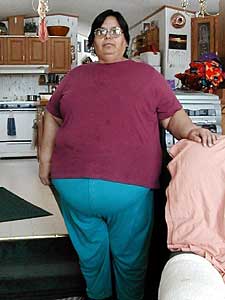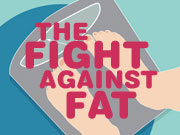|
Audio
Photos
More from MPR
Resources
Respond to this story
|
Weight loss surgery: the last resort?
June 2, 2003
 |
| Gail Hocking, 54, has battled obesity all her life. She weighed 360 pounds when this photo was taken in mid-March. Hocking decided to try gastric bypass surgery as a last resort. She underwent the surgery this spring, and has already lost more than 50 pounds. (MPR Photo/Tom Robertson) |
Bemidji, Minn. — Gastric bypass surgery is sometimes called stomach stapling. Dr. Daniel Smith, a surgeon in Park Rapids, has been doing the procedure for 12 years.
"When the person leaves the operating room, their functioning stomach is actually about the size of a ping pong ball," says Smith. "And so three spoonfuls of something like cottage cheese, they'll actually be full."
Last year, about 63,000 severely obese Americans had the bypass. That's nearly twice as many as in 2000.
 | |||
The surgery isn't for everyone. Patients must be at least 100 lbs. overweight. Gail Hocking qualifies.
It's early March. Hocking is out of breath after simply answering the door. She's 54 and weighs 360 pounds. She can't walk to the end of her driveway without stopping to rest. Stairs are worse.
"When I get back up, I am puffing so bad, it takes me a good five minutes to recuperate from just a flight of stairs," said Hocking.
Hocking lives in rural Solway in northwestern Minnesota. She grew up on the Red Lake Indian Reservation. She remembers weighing 150 pounds in fifth grade. By age 19, she weighed 250.
"Schoolmates would say, 'Oh, you big fat pig,' or 'You big fat slob.' And that hurt. It hurt a lot," said Hocking. "It took me a long time to learn to like myself."
Hocking can't bend over to tie her shoes. She never goes to the movies, because the seats are too small. She can't shop for clothes in local stores. They don't carry her size.
|
I'm addicted to food. Food is my best friend. If I'm feeling happy, I eat. If I'm feeling sad, I eat. I love to cook. I mean, I got a collection of cookbooks of over 200.
- Gail Hocking |
Hocking admits she overeats. She also realizes she has an unhealthy psychological relationship with food.
"I'm addicted to food," she said. "Food is my best friend. If I'm feeling happy, I eat. If I'm feeling sad, I eat. I love to cook. I mean, I got a collection of cookbooks there, of over 200."
Hocking knows her excessive weight is putting her life at risk. She's on three types of blood pressure medications. She has chronic arthritis and has had three knee surgeries. Both her parents have diabetes. She worries she'll be next.
Hocking has tried all sorts of diets, but none were successful. In 1978, she tried weight loss surgery. She lost a lot of weight at first -- 125 pounds. But then the staples popped. Her stomach got big again, and so did she.
Gail Hocking has decided to try surgery again -- this time, the popular gastric bypass. "I figure that if I don't do it, I'll be in a wheelchair within a year," said Hocking. "I'm not doing this for vanity."
An Internet search led Gail Hocking to Dr. Daniel Smith at St. Joseph's hospital in Park Rapids. It's become a regional center for the procedure. Smith does about 10 bypasses a week. Patients come from across Minnesota, Canada and neighboring states.
 | |||
"If you were to hang around the clinic today, probably the happiest people in the clinic are the post-operative gastric bypass patients," said Smith. "You've gone from a whole set of real severe medical problems, and we really kind of turn their life around."
On the morning of Gail Hocking's surgery, she's lying flat on a table in a white operating room. Gail falls asleep, and within a few minutes, Dr. Smith and his team begin.
"We're making the abominal incision, and basically go through the skin and fat layer ... we'll be inside the abdomen shortly," said Smith. Smith separates Hocking's stomach into two sections. He creates the small pouch that will hold her food. The surgery bypasses about 250 centimeters of Hocking's small intestine. This slows down the flow of food out of the stomach.
 | |||
The procedure takes about two hours. Hocking will spend the next four days in the hospital. She'll be on a liquid diet at first. She'll slowly move back to solid food in the coming weeks.
The procedure will soon be more common in Park Rapids. The hospital plans to build an entire wing dedicated to gastric bypass patients. They're hiring another surgeon, too. By next year, they expect to do 20 bypasses a week.
The before and after pictures of gastric bypass patients are astounding. Success stories have gotten lots of attention in the media. But as many as 20 percent will require follow-up operations to correct complications.
Karen Thompson is a radio DJ in Bemidji. Her listeners know her better as "Bubbles." Thompson had the bypass surgery in 1995. At the time, she weighed nearly 400 pounds. Within days, an intestinal leak caused a major infection.
"When I sat up on the edge of my bed, two and a half quarts of green fluid and infection burst out of my stomach," said Thompson. "Nurses were scrambling everywhere."
Thompson spent the next 32 days in intensive care. She nearly died.
 | |||
"Surgeons paint a glamorous picture of what it is like to have this surgery, and your life is going to be wonderful," she said. "There are complications, and I have had just about every complication you can think of."
Thompson needed more than a dozen corrective surgeries. This past March, she had a second gastric bypass. Since the first operation eight years ago, Thompson has lost 224 pounds. Now she's dropping more weight. She says despite the hell she went through, she'd do it all again.
Six weeks after Gail Hocking had her bypass, she squats down on the floor to play with her grandchildren. It's something she couldn't do before the surgery. She's lost 50 pounds, but has severe problems with diarrhea. It's a side-effect she didn't expect.
"When I first come home, oh, I'd sit and cry and cry because I thought, 'Why did I do this?'" said Hocking. "I'd rather just stay fat and be in a wheelchair, than to have to live in my bedroom so I can be 10 feet from the bathroom."
Hocking now eats dramatically less. There are some foods her body will no longer digest, and she'll have to take vitamins for the rest of her life. But Hocking's face is noticably thinner, and she no longer needs to take her blood pressure medication.
Hocking says she has no regrets about the surgery. The hardest part for her is learning to deal with her lifelong issues with food.
"It's taking a lot of adjustment," said Hocking. "I didn't realize how much I enjoyed food. There's so much that I can't eat now, that I used to just love to eat. But food is an addiction, and I'm so thankful that I have a surgical tool to help me with my addiction."
Health experts are encouraged by some new weight loss drugs now in development. But many are years away from being available. Until then, experts predict continued growth in the number of severely obese people who turn to surgery as their last resort.
|
News Headlines
|
Related Subjects
|

